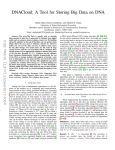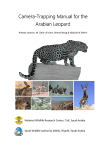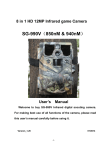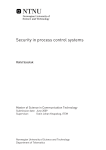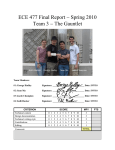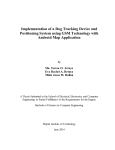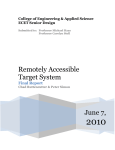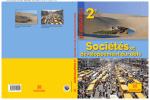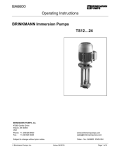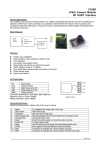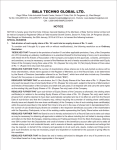Download TigerCENSE: Wireless Image Sensor Network to Monitor Tiger
Transcript
TigerCENSE: Wireless Image Sensor Network to
Monitor Tiger Movement
Ravi Bagree, Vishwas Raj Jain, Aman Kumar, and Prabhat Ranjan
Dhirubhai Ambani Institute of Information and Communication Technology,
Gandhinagar, India - 382007
{ravi bagree,vishwas jain,aman kumar,prabhat ranjan}@daiict.ac.in
Abstract. Wireless Sensor Network (WSN) in combination with image
sensors opens plethora of opportunities in the wildlife tracking. It provides a glimpse into previously unseen, remote and inaccessible world of
some of the most endangered species on earth. tigerCENSE 1 is such an
attempt to put sensor network technology in conserving one of the rarest
and most elusive big cat species. The node, triggered by the Passive Infrared (PIR) sensor, captures the image of tiger using a CMOS image
sensor and stores it in an external memory chip. To avoid any disturbance
to animal, the node uses an Infrared (IR) flash, instead of white flash,
to illuminate the target at night. The stored images get transferred to
the base station via radio transceiver. This is transferred to the database
server through Internet links for analysis by wildlife researchers. A solar
energy harvesting system for recharging node’s batteries is being added
to avoid frequent human visit to change the batteries, making it highly
non-intrusive system.
Keywords: Camera Trap; Wireless Sensor Network; Image Sensor Network; wildlife tracking; Intrusion detection; CMOS camera; IR flash;
image sensor.
1
Introduction
Most of the WSN applications have depended on sensors such as light and temperature etc., which produce small amount of data per sample. However, in
recent years, technological advances, especially in CMOS, have made it possible
to have very small, low powered and cheap image sensors integrated to WSN,
enabling us to collect valuable visual information of the target object and its
surroundings. These image sensors produce large data per sample based on image size. Due to this Wireless Image Sensor Network (WiSN) has emerged as a
new field with its own application areas as well as challenges. One of its most
promising applications is monitoring wildlife species.
1
Corresponding author.
This project is partially funded by Wildlife Institute of India, Dehradun.
P.J. Marron et al. (Eds.): REALWSN 2010, LNCS 6511, pp. 13–24, 2010.
c Springer-Verlag Berlin Heidelberg 2010
14
R. Bagree et al.
Traditional methods of wildlife monitoring are largely based on statistical
methods and data collected by ground surveys [1]. Though these methods usually yield extensive data for a given animal and its habitat, they are time consuming, expensive and unauthenticated. Some methods, such as the traditional
pugmark census, are not even reliable enough[2]. Above all, most of the endangered or critically endangered species live in remote, arid and inaccessible
landscape. Monitoring them, their behavior, their status and distribution becomes life threatening. tigerCENSE is an attempt in this direction to make such
tracking more authentic, automated, non-intrusive, less expensive and safe. Under tigerCENSE project we are primarily focusing on collecting images of tigers
along with its time/date and location to identify their movement patterns and
making it available to the researchers in an easy manner.
Tiger is the largest of all the Asian big cats and one of the most threatened
species [3]. Throughout their range in Asia tiger populations are threatened,
either directly from poaching, or from habitat and prey loss [4]. Once having
the population count above one million is now struggling for its survival with
the mere population of 3,402-5,140 across the world [4]. In last few decades
number of conservation programs have been proposed by various countries and
other international organizations. They have been working on many possible
solutions like restoring habitat, monitoring populations, anti-poaching laws etc,
and millions of dollars have been invested for the same [5]. But common to all
the solutions is monitoring the status and population distribution information
of the tigers.
2
Available Technology
The advent of advance camera trap technology has revolutionized conservation
plans for wildlife. It helped to uncover invaluable information about rare species
and their habitats, which can be shared with local governments when making land-use decisions, anti-poaching activities etc. Most of the available camera traps use independent commercially available camera modules, that may be
digital or film-based usually triggered by a motion detector.
In the very old days trip wires and pressure pads were used to trigger cameras
[2]. Modern motion detectors are based on infrared and may be active or passive.
Active infrared based motion detectors send out an infrared beam to a receptor
located some distance away. When any object obstructs this beam’s path, the
detector triggers and camera captures the photograph. Whereas a PIR sensor
tracks heat change in the surrounding. When any infrared emitting object passes
in front of the detector, it detects the motion. Also, the modules that aim for
night photography usually come equipped with either white or infrared flash.
Some of the commercial cameras use almost 64 LEDs making them much bigger
and consume lot of power.
These systems usually use strobes and wires to interconnect the motion detector, the independent camera and to setup an automatic image capturing system.
This makes their size quite bulky and difficult to camouflage making it highly
prone to stealing by people or being damaged by animals. Also, presently most
TigerCENSE: Wireless Image Sensor Network
15
of the commercially available traps do not have a local wireless network link. Although few of the traps do communicate with satellite but because of the leased
satellite link, they cost heavily.
In this paper we are proposing the system, tigerCENSE, which has been able to
resolve many of the problems faced by these traditional camera traps. Here we will
be discussing the hardware and software design architecture of the tigerCENSE
system at the node, base and network levels. In particular, the paper embodies the
issues and constraints, which were met during the design and testing of the system.
Section 3 of the paper discusses the design parameters taken into account
for tigerCENSE. Overview of the system is described in Section 4 covering the
hardware and software aspects of the system. Experience gained, system performance and our field testing results are covered in Section 5. Finally we conclude
by enumerating the challenges and experience gained from inception to trials.
3
tigerCENSE
To make an informed decision, researchers need to know the status and distribution pattern of tigers in the area of interest. They collect information using
pugmark, DNA technique or through camera traps. As human beings have fingerprints as their unique identity, characteristic stripe patterns on cat’s body
differ from one individual to another and from one side of the cat’s body to
the other [6]. In fact, there are no tigers with identical markings. Wildlife researchers are mainly interested in these unique stripes pattern. It allows them to
extract potential information on the presence of species, their home range sizes,
individual recognition and density estimates, activity cycles, behavior, seasonal
variation in movement and abundance and also allows for comparisons to be
made between areas [2].
tigerCENSE is an attempt in the similar direction and provides images in an
inexpensive, power and time efficient manner. Nodes are setup by researchers
along each bifurcation of the tiger trail to help figure out the path taken by
tiger. Whenever a tiger gets in the field of view of PIR sensor, an interrupt is
generated and the image sensor will capture the photograph. As tiger moves
mostly in night, an infrared flash is integrated in the system. The photograph
is time stamped and gets stored on a micro-SD card along with node ID. Once
the communication with gateway or next hop neighbor is available, it would
transfer the image wirelessly using a radio transceiver. As the memory size of
the micro-SD card can be increased, the upper limit of photographs that can be
saved is adjustable. Also, wireless connectivity and solar recharging for battery,
help in minimum anthropogenic disturbance, which otherwise would have been
required for data collection and to change the power battery.
Though camera traps technology have been in use for quite long time but
still it is not fully explored and suffer some major drawbacks. Besides having
all the pros of old traps, tigerCENSE has been designed keeping the following
drawbacks, explained further, as its prime design challenges.
16
R. Bagree et al.
Response Time. The time delay between PIR interrupt and capturing the
photograph is very critical. Because of large response time of many traditional
traps, fast moving animals do not get captured. tigerCENSE system needs to
reduce this time to around one second to overcome the said drawback.
Size and Cost. Traditional traps were bulky and costly. Developing a customized system with an integrated image sensor is desirable as this will drastically reduce the size and the cost. Also, presently the number of LEDs used to
illuminate the animal is very high. We could make an illuminator with fewer but
brighter and more efficient LEDs.
Disturbance to Animals. To allow night photography IR flash is recommended as white flash will startle the animal resulting in the abandonment
of the path. Also, mechanical shutter produces a click sound, while taking a
photograph. This needs to be avoided as this makes the animal cautious of its
surrounding and to behave abnormally.
Automated Data Transmission and Local Storage. A wireless connectivity is required which allows the nodes to be deployed in very remote areas and it
will also reduce human visit to the forest to a great extent. Also, to compensate
for any link failure due to environment or other failures, the node should have
sufficient external memory to store the data for a month.
Remote Configuration. Researchers need to go to the field each time they
need to change any parameter, like number of shots in burst mode, delay between
two adjacent shots etc. of the traps. Remotely changing of parameter further
reduces the visit and labor of researchers.
Fail-Proof against False Interrupts. In spring when many trees shed their
leaves in preparation for new foliage, active IR sensor gives lot of false interrupts.
Each momentary break in the beam caused by a leaf floating across the path
may result in a useless picture being taken. tigerCENSE needs to take care of it
as this may consume large amount of power for no good reason.
Health Information of Traps. Presently, once the trap is deployed in the
field, there is no way to know about its health and other parameters. The film or
the battery might have been exhausted long back but the researchers would not
know. Also, the camera might stop working because of some technical problems,
it might get stolen or may have been damaged by an animal, but it will remain
unknown until someone visits it. This makes the trap highly inefficient as it may
loose important information.
Energy Harvesting. Present traps consume enormous power and need the
battery replacement at regular interval. This not only leads to frequent visit
of the researchers but also the maintenance cost goes up. This requires for an
efficient power supply with a recharging mechanism. The Solar recharging system
could be an excellent solution to it. With careful energy management policy,
supplemented by harvesting, the energy requirements can be met.
TigerCENSE: Wireless Image Sensor Network
17
Fig. 1. tigerCENSE Hardware setup depicting various components, their interfacing
and power supply
4
System Overview
Broadly the tigerCENSE system is divided like any other traditional WSN in the
hardware, related system software and drivers, middle-ware servers with data logging and web hosting services and finally the browser based visualization software.
We plan to use radio transceivers capable of communicating over 1.5 km in the free
space. The range may get affected due to surroundings but would still be sufficient
to allow node to node communication and multihopping of data. Most of the nodes
would be in the valley but to provide link to Internet, we would need to use GPRS
links using mobile communication infrastructure. As mobile signals would not be
available in the valley, we would need to setup a 4-5 km directional link between
a gateway in the valley and that on the hills. Using mobile signal available on the
hills, we would be able to transfer the data to servers using GPRS. Our focus in
this paper is more on the node development and not on the rest of the system,
where standard existing technology can be used.
This section describes the platform developed and used for our experiments.
Hardware system architecture of tigerCENSE node is as depicted in Figure 1.
While describing the hardware used, we will also discuss the flow of the software
and the challenges faced during its development.
When the system is in idle state with no movements of animal, all the hardware components will be in power saving or sleep mode except the PIR sensor.
When an intrusion is detected PIR sends an interrupt to the micro-controller
and the system gets into its active state. The PIR Sensor is a pyro-electric device
that detects the motion by measuring changes in the infrared levels emitted by
surrounding objects.
PIR. We use Parallax INC #555-28027[8] PIR sensor, which works from 3.3 to
5V and draws less then 100 μA current. Also, it is less prone to false triggers,
18
R. Bagree et al.
when compared to active beam interrupted motion detectors. Active beam based
system may get triggered by a very small object(e.g. leaves falling of a tree). It
has the Fresnel lens with the viewing angle of 90 degree and a range of approximately 20 feet. At start-up the PIR requires a ‘warm-up’ time in order to learn
its environment or in other words creating the heat map of the environment. This
start-up time could be anywhere from 10-60 seconds. After this, whenever PIR
sensor detects any sudden change in its heat map, in other words it detects an
intrusion; it pulls up its output pin giving an interrupt to the micro-controller.
The interrupt from the PIR wakes up the micro-controller and it initializes the
image sensor to take the photograph. The initialization of image sensor happens
in two steps. In the first step the micro-controller enables the power to the
image sensor using a power switch TPS2092 [9]. The power switch is being used
to conserve the power which otherwise would be wasted as the quiescent power
of the image sensor. In the second step the micro-controller sends commands to
the image sensor to customize setting and to capture the image.
Image Sensor. COMedia Ltd.’s C328R [10] image sensor module is used, which
performs as a JPEG compressed, low cost, low powered still camera. It interfaces
with the micro-controller using the serial communication. It works on 3.3V with
60mA of current. As we are using IR flash to illuminate the object, we use a lens
without IR filter. CMOS image sensors are typically sensitive to 1000 nm and
use of IR LED in 850 nm to 950 nm range to illuminate the target is possible.
The lens configuration can also be altered to vary the Field of View (FOV) of
the camera [11]. Currently, we are using the lens with FOV of 60 degree.
Before taking the photograph the micro-controller reads the output of a photoresistor, interfaced to its ADC pin, to sense whether the ambient light is sufficient
for the image or if flash is required. Depending on the need, micro-controller
switches on the high intensity Infra-Red Flash using a power MOSFET.
All the photographs need to be time stamped along with the node ID. To
keep track of time on the node, we are using a Real Time Clock (RTC). When
the node is powered on for the first time, it needs to be in the range of a base
station to synchronize with the system time. Once the time is set, the battery
backed RTC keeps the timing information for years and corrects any drift each
time node communicates with the base.
Real Time Clock (RTC). We use DS3231[12] as RTC, which is one of the
industry’s most accurate RTC. Its power consumption is 110 μA at 3.3V. It
has integrated temperature compensated crystal oscillator (TCXO) and I 2 C
interfacing.
A radio transceiver has been used to transfer the collected photographs and
other data/health information of the node to the gateway/base station for onward transmission to the server.
Radio-Transceiver. Communication module XBee Pro[13] from Digi-Key is
used, which is based on ZigBee/IEEE 802.15.4 standard. It operates at 2.4 GHz
(only freely available ISM band in India), providing a range of more than a
kilometer. Its RF data rate is 250 Kbps. While using this frequency results in
TigerCENSE: Wireless Image Sensor Network
19
higher power consumption for same range compared to 900 MHz, we gain in
terms of much higher data rate and smaller compact antenna. Low cost, low
power and ease of use are among the other advantages. It also provides five sleep
modes to meet various needs of different applications. We use lowest power sleep
mode as it is not a time but power critical system. Recently introduced, XBee
Pro 2.5 version supports multihop transfer of data.
The image can be transferred using multihop facility provided by XBee Pro
2.5. But there are chances, because of bad weather or some other technical
problem, establishing a communication link is not always possible for a sensor
node especially those deployed in remote areas. So the captured image needs to
be stored in some storage device. Typically the size of a photograph is 60KB. So
we cannot use an internal memory and need an external storage.
Micro-SD Card. We have used micro Secure Digital (SD)[14] card, commonly
used in mobile phones, which can be interfaced with micro-controller using SPI
bus. The card can be manually removed and the images can be transferred into a
computer, phone or even a digital camera for viewing. The conventional method
of writing data into external flash memory restricts the user from viewing the
images with such ease. The storage capacity of the micro-SD card is adjustable
depending on the activity of the animal at the location. Currently we are using
a 2GB card.
All the decision making and controlling of components on the node is done
centrally by the micro-controller.
Micro-controller. ATMega1281V [15], with 128K bytes program memory, is the
core processing unit of our design. It has 4K bytes of EEPROM and 8K bytes of
SRAM. The availability of 2 USART ports enables independent communication
of Camera and Radio transceiver with the core processing unit. The internal resonator is not accurate enough for serial communication, so an external crystal of
1.83728 MHz is used. (Limiting baud error to zero percent [15]).
An efficient energy power supply and management policy has been designed to
achieve true non-intrusive nature of tigerCENSE. Energy efficiency is achieved
by using very low loss DC/DC converter and other components such as power
switch to switch off all the devices, whose sleep mode power consumption is not
sufficiently low. All the peripherals are switched off or kept in sleeping mode,
except PIR sensor, in normal mode. The system is powered by a re-chargeable
Li-poly battery. Solar energy harvesting is being added to further enhance the
node life. The battery’s capacity should be sufficient enough to power the node
for at least one month. We are carrying out tests to determine node’s actual life
time in working environment.
Battery. We are using a 6AH Li-poly battery[16]. These are very slim, extremely
light weight batteries based on the new Polymer Lithium Ion chemistry. Its output
voltage is 3.7V with 2.7V cut-off voltage. Also it has 2C discharge rate.
Designing a simple power supply for such complex system was a challenge. All
components and sensors were carefully selected to have low energy consumption
profile and almost similar input supply range with 3.3V as the common voltage.
The decision of using a common voltage (3.3V) not only made the power supply
20
R. Bagree et al.
for the node simple but also saved energy, which otherwise, would have been
wasted in regulating it for different voltages. With time the battery voltage will
reduce from 3.7V to 2.7V. But the node needs a constant voltage supply of 3.3V
so we need a buck-boost DC converter to regulate the battery voltage.
Buck Boost Converter. To utilize the battery power to the maximum, a
DC/DC converter, TPS63001[17] buck boost converter from Texas Instruments,
is used. It provides a constant 3.3V output with a maximum of 1.8A of current;
being rated up to 96% efficient.
The same battery will be used to power the IR LEDs. These LEDs will be
used in pulse mode with high time of 30ms. To get high intensity rays, we need to
supply very large current (approx. 3.0 A) for this pulse duration . As a battery
may not supply such large current, we need buffer storage of electric charge
in between. Super-capacitor is the best option for this task. We are using two
super-capacitors in series to get the required voltage.
Super-Capacitor. Super-capacitor TS12S-R[18] is used, which is highly compact and high density capacitor with capacity of 10F at 2.5V. Its self discharge
rate is very low and can supply maximum of 4.5A of current.
To switch on the LEDs for such a short time, we need a Power MOSFET with
very small ON time resistance. ON time resistance is of particular importance as
we are drawing very high current of 2.5A. Even few milliohms of ON resistance
can result in significant voltage drop across LEDs, which will reduce its intensity
severely.
Power MOSFET. The Power MOSFET STB100NF03L[19] from ST Microelectronics has been used for the said task. Its ON-resistance is less than 3.2 mΩ
with Gate threshold voltage is as low as 1.7V.
Tigers mostly move in night time and to illuminate the animal, we are using
IR LEDs. But since the size of the trap is of much concern, we need to use
least no. of LEDs possible. This requires very high radiant intensity, low forward
voltage LEDs.
IR LED. We use TSHG5210[20], which is the strongest high intensity IR LED
available in the market from Vishay Semiconductors. This is an infrared, 850nm
emitting diode with forward voltage of 1.5V. In pulse mode its radiant power is
2300mW/sr. Its angle of half intensity is +/- 10 degree. However, one may need
wider beam angle than what this provides.
Right now the system uses 12 LEDs in parallel. We are working on the ways to
reduce the number of LEDs to about 5-6 by improving the charge buffer system.
We selected parallel configuration as it is easy to provide a large current instead
of high voltage. Also, in such configuration each LED is independent of the other
and failure of one LED does not disturb the function of whole flash.
Learning from the experience for wildCENSE[21] project the node has been
designed employing numerous noise reduction techniques. To reduce the ADC
noise, a LC filter (L=10mH and C=0.1μF ) has been added to the ADC pins
of the micro-controller. Also, the AVcc is connected to the main power supply
TigerCENSE: Wireless Image Sensor Network
21
Fig. 2. tigerCENSE node, Front and Rear view
without any in between fan out lines, to reduce noise [22]. The whole PCB has
copper pouring to keep the noise at a minimum level as also to dissipate any
heat generated by the node. Figure 2 depicts the PCB made for the node. The
size of the populated PCB is 3.8 x 5.6 x 3.1cm3 , weighing only 43 gms excluding
power supply and enclosure.
5
Experimental Results
Based on the expected speed of movement and width of walkways(assumed 10
feet) and distance of node from walkway to be 10 feet, a delay of 1.8 sec is kept
Fig. 3. Prototype box used for testing
22
R. Bagree et al.
Fig. 4. Photograph clicked using IR Flash in dark night
between the PIR interrupt and capturing a photograph of the object. Minimum
delay achievable seems to be 250 ms. It is extremely small time as compared
to the response time of traditional traps which ranges into few seconds. Also,
minimum delay between two continuous shots has been found out to be 1s. It is
dictated by the time to transfer the data from Image Sensor to Micro-SD card
and can be reduced by buffering it in a fast memory, if one needs to collect a
burst of images.
To find out the minimum suitable ON time for the IR flash to capture the
stripes clearly on its body, we deployed a prototype box, as shown in Figure 3,
near the cage of a tiger in Kankaria Zoo, Ahmedabad, Gujarat. We programmed
the node to take pictures with increasing ON time starting from 10ms to 70ms
with an increment of 10ms. Figure 4 shows some of the photographs taken by
the node in the dark using an IR Flash. From the experiments we concluded
that an ON time of 30ms is sufficient to get a reasonable quality image with
clear stripes. We need flash time to be as low as possible to reduce blur due to
motion. Some commercial digital cameras use 125 ms flash time, which leads to
significant blare to the extent of image being useless.
6
Conclusion
This paper presents an operational prototype for wildlife monitoring using WiSN.
tigerCENSE is compact, non-intrusive, energy efficient and reliable sensing device. It not only has all the capabilities of traditional traps but has also addressed
most of the drawbacks of them. Integrated development has led to minimum delay of 250 ms. The software protocols and the hardware implementation have
TigerCENSE: Wireless Image Sensor Network
23
all been carefully crafted to optimize the systems energy requirement. Further,
utilizing the solar recharging mechanism, node lifetime would be enhanced.
In future, we can also add some micro-climatic sensors in order to collect
ambiance information. Also, to reduce the amount of wireless data transfer, we
can deploy in-situ digital signal processing technique. This will help us save both
power and time which is highly crucial for the success of the system.
tigerCENSE has been mainly developed to help in the research and conserving
tigers. Besides the use for conducting a census, camera traps can be very useful
for many management tasks. It can be used for human surveillance as well. In
the past, traps have photographed poaching parties. Although due to latency in
collecting the photograph target animal prey were not saved but it eventually
led to the arrest and conviction of known offenders.
Acknowledgment
We would like to thank Bharat Jethwa of GEER foundation (Gandhinagar) for
always being available when needed. Discussion with WII researchers P R Sinha
(Director), S P Goyal, K Sankar, B Pandav, Q Qureshi and others have been
very helpful. We would also like to thank R K Sahu(Superintendent) and others
of Kankaria Zoo, Ahmedabad for giving us permission to carry out trials as
well as helping in the process. We would also like to acknowledge tremendous
contribution made by earlier team members of tigerCENSE, especially Amrit
Panda, Rigveda Kadam, Dheeraj Kota and Hemant Kavadiya.
References
1. Yasuda, M., Kawakami, K.: New method of monitoring remote wildlife via the
Internet. Ecological Research 17, 119–124 (2002)
2. Nath, L.: Camera Trap in Conservation, http://www.nfwf.org/AM/Template.cfm?
Section=Home&TEMPLATE=/CM/ContentDisplay.cfm&CONTENTID=8749
3. http://www.panda.org/what_we_do/endangered_species/tigers/
4. http://www.iucnredlist.org/details/15955/0
5. Staving Off Extinction: A Decade of Investments to Save the World’s Last Wild
Tigers (1995-2004),
http://www.nfwf.org/Content/ContentFolders/NationalFishandWildlife
Foundation/ConservationLibrary/ProgramEvaluations/Staving off
Extinction.pdf
6. McDougal, C.: The Face of the Tiger. Rivington Books, London (1977)
7. http://www.panda.org/what_we_do/endangered_species/tigers/tiger_
solutions/
8. PIR Parallax 555-18017 Datasheet, http://www.parallax.com/detail.asp?
product_id=555-28027
9. Texas Instrument TPS2092 Datasheet, http://www.ti.com/lit/gpn/tps2092
10. COMedia Ltd’s C328RS User-Manual, http://www.electronics123.net/amazon/
datasheet/C328R_UM.pdf
11. Lens of camera, http://www.electronics123.net/amazon/datasheet/C328R.pdf
24
R. Bagree et al.
12. DS3231 RTC Datasheet, http://www.maxim-ic.com/quick_view2.cfm/qv_pk/
4627
13. XBee-PRO OEM RF Modules Product manual, http://www.maxstream.net/
products/XBee/product-manual_XBee_OEM_RFModules.pdf
14. micro-SD Card Datasheet, http://www.sparkfun.com/datasheets/Prototyping/
microSD_Spec.pdf
15. Atmel ATMega1281 Datasheet, http://www.atmel.com/dyn/resources/prod_
documents/doc2549.pdf
16. Polymer Lithium Ion Batteries 6Ah Datasheet, http://www.sparkfun.com/
datasheets/Batteries/UnionBattery-2000mAh.pdf
17. Texas Instruments TPS63001 Datasheet, http://www.ti.com/lit/gpn/tps63001
18. Suntan Super-capacitor TS12S-R Datasheet, http://www.sparkfun.com/
datasheets/Components/TS12S-R.pdf
19. ST microelectronics Power MOSFET STB100NF03L Datasheet, http://www.st.
com/stonline/products/literature/ds/9307.pdf
20. Vishay Semiconductor IR LEDs TSHG5210 Datasheet, http://www.vishay.com/
docs/81810/tshg5210.pdf
21. Jain, V.R., Bagree, R., Kumar, A., Ranjan, P.: wildCENSE: GPS base Animal
Tracking System. In: International Conference on Intelligent Sensors, Sensor Networks and Information Processing, Sydney, December 15-16 (2008)
22. Innovative Techniques for Extremely Low Power Consumption with 8-bit Microcontrollers,
http://www.atmel.com/dyn/resources/prod_documents/doc7903.pdf













